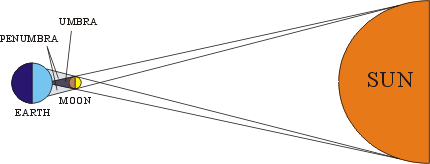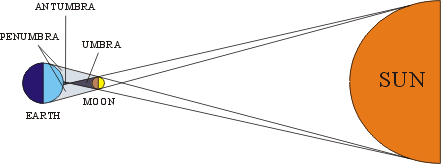Explanation of Solar Eclipse
Solar eclipse occurs when the Moon is in line between the Earth and the Sun (see Figure 1). The Moon casts a shadow on the Earth's surface and obscures some parts of the Sun. The proportion of the Sun being blocked depends on the position of the observer on the Earth. When only the Moon's penumbral shadow strikes the Earth, a partial eclipse of the Sun is observed. However, if the Moon's dark umbral shadow sweeps across Earth's surface, a total eclipse of the Sun is seen.

Figure 1 Relative positions of the Sun, the Moon and the Earth during a total solar eclipse
Sometimes the Moon is farther away from the Earth and its umbral shadow is not long enough to reach the Earth. The Moon appears smaller than the Sun and cannot completely cover it (see Figure 2). Instead, the antumbra reaches the Earth. If you are within this shadow, you will see an eclipse where a ring or 'annulus' of bright sunlight surrounds the Moon at the maximum phase. Those within the penumbra would observe a partial eclipse.

Figure 2 Relative positions of the Sun, the Moon and the Earth during an annular solar eclipse